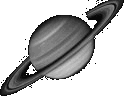|
1674: Robert Hooke, attempt to explain planetary motion as a balance of centfifugal force and gravitational attraction
1675: Giovanni Cassini, Saturns has separated rings which must be composed of small objects
1675: Isaac Newton, delivers his theory of light
1676: Olaus Roemer, measured the speed of light by observing Jupiter's moons
1676: Robert Hooke, law of elasticity and springs
1676: Edme Mariotte, pressure is inversely proportional to volume (Boyle's law) and height of atmosphere
1678: Robert Hooke, inverse square law of gravity
1678: Christiaan Huygens, writes about wave theory of light
1679: Christiaan Huygens, polarisation of light
1680: Isaac Newton, demonstrates that inverse square law implies eliptical orbits
1684: Isaac Newton, inverse square law and mass dependence of gravity
1684: Gottfreid Leibniz, differential calculus
1687: Isaac Newton, publishes laws of motion and gravitation
1687: Isaac Newton, publishes analysis of sound propagation
1688: P. Varignon, addition of forces
1690: Christiaan Huygens, principle of Huygens, secondary waves
1690: John Locke, knowledge comes only from experience and sensations
1692: Richard Bentley, why do stars not fall together under gravitation?
1702: Francis Hauksbee, rarified air glows during electrical discharge
1704: Isaac Newton, publishes corpuscular theory of light and colour
1705: Edmund Halley, noticed that three previous comets are the same and predicts its return in 1758
1709: Gabriel Fahrenheit, alcohol thermometer
1710: George Berkeley, idealist philosophy against materialist
1714: Gottfreid Leibniz, energy conservation
1714: Gottfreid Leibniz, rejection of absolute space and time
1714: Gabriel Fahrenheit, mercury thermometer
1718: Edmund Halley, measures proper motion of stars
1720: Edmund Halley, early form of Olbers' paradox
1721: George Berkeley, space exists because of matter in it
1724: Gabriel Fahrenheit, supercooling of water
1727: Stephen Hales, makes oxygen
1728: James Bradley, speed of light and stellar aberration
1729: Stephen Gray, conduction of electricity
1731: Rene Reaumur, alcohol/water thermometer
1733: Charles Du Fay, recognises distinction between positive and negative electric charge
1735: Antonio de Ulloa, element platinum
1736: Leonhard Euler, differential equations in mechanics
1738: Daniel Bernoulli, kinetic theory of gas
1738: Daniel Bernoulli, hydrodynamics
1739: Georg Brandt, element cobalt
1740: Pierre Bouguer, gravitational anomalies
1742: Anders Celsius, reverse centigrade temperature scale
1743: Jean Christin, Celsius temperature scale
1743: Jean d'Alembert, energy in Newtonian mechanics
1744: Pierre de Maupertuis, principle of least action
1744: Jean d'Alembert, theory of fluid dynamics
1744: Leonhard Euler, Euler-Lagrange equations
1744: Mikhail Lomonosov, heat is a form of motion
1745: von Kleist, van Musschenbroek, Leyden jar for electric charge storage
1746: Andreas Marggraf, rediscovery of element zinc
1746: Leonhard Euler, wave theory of light refraction and dispersion
1747: d'Alembert, Euler, solution of equations for vibrating string
1748: Mikhail Lomonosov, conservation of mass and energy
1749: Thomas Melvill, early spectrscopy and yellow line of sodium in salt
1750: Benjamin Franklin, theory of electricity and lightning
1750: John Michell, magnetic induction
1750: John Michell, inverse square law for magnetic fields
1750: Thomas Wright, Milky Way could be due to slab like distribution of stars
1751: Benjamin Franklin, electricity can magnetise needles
1751: Frederik Cronstedt, element nickel
1752: Jean d'Alembert, viscosity
1754: Joseph Black, discovery of carbon dioxide showing that there are gases other than air
1755: Immanuel Kant, theory that the universe formed from a spinning nebula in an infinite hierarchy
1756: William Cullen, evaporation causes cooling
1756: Mikhail Lomonosov, supports wave theory of light
1761: Joseph Black, discovery and measurements of latent and specific heats
1761: John Harrison, portable chronometer
1765: Leonhard Euler, rigid body motions
1766: Joseph Priestley, inverse square law for electric charge
1766: Henry Cavendish, hydrogen is an element
1771: Luigi Galvani, electricity in animals
1772: Carl Scheele, saw air as two gases one of which encouraged combustion
1772: Daniel Rutherford, nitrogen
1772: Antoine Lavoisier, conservation of mass in chemical reactions
1772: Joseph Lagrange, theory of Lagrange points
1774: Priestley, Scheele, element oxygen
1774: Nevil Maskelyne, gravitational deflection of plumb line by a mountain
1774: Carl Scheele, element chlorine
1774: Johann Gahn, element manganese
1775: Alessandro Volta, electrical condenser
1776: Pierre-Simon Laplace, deterministic causality
1777: Antoine Lavoisier, composition of air and burning as a chemical reaction
1779: Charles Augustin de Coulomb, Coulomb's law of friction
1781: Immanuel Kant, Critique of pure reason
1781: William Herschel, discovery of Uranus
1781: Carl Scheele, element molybdenum in ore
1781: Charles Messier, catalogue of nebulae
1781: Heinrich Olbers, Uranus is a planet, not a comet
1782: Jacob Hjelm, isolation of element molybdenum
1782: Franz von Reichstein, element tellurium in ores
1782: William Herschel, catalog of double stars
1782: William Herschel, sun's motion through space
1783: John Michell, Newtonian black hole
1783: Fausto and Juan Josť de Elhuyar, element tungsten
1783: Rene Hauy, nature of crystals
1784: Henry Cavendish, water is a compound of oxygen and hydrogen
1784: Pierre Laplace, electrostatic potential
1785: Charles Augustin de Coulomb, electric force proportional to product of charges and inverse square of distance
1786: Antoine Lavoisier, distinction between elements and compounds
1787: Antoine Lavoisier, system for naming chemicals
1787: Jacques-Alexander Charles, law of gas expansion with temperature
1788: Joseph Lagrange, Lagrangian mechanics
1788: John Hunter, Diffusion of heat
1789: Antoine Lavoisier, Conservation of mass in chemical reactions
1789: Martin Klaproth, elements zirconium and uranium in compounds
1790: Definition of metric system in France
1790: Adair Crawford, element strontium in compounds
1791: William Gregor, element titanium in compounds
1794: Johann Gadolin, element yttrium in compounds
1794: Pierre Laplace, analysis of Newtonian black hole
1796: Alessandro Volta, chemical batteries and voltage
1797: Henry Cavendish, measured the gravitational constant with a torsion balance
1797: Nicholas Vauquelin, element berylium idnetified in gem stones
1797: Nicholas Vauquelin, element chromium
1798: Benjamin Thompson, heat generated equals work done
1798: M. Klaproth, isolation of element tellurium
1798: Humphry Davy, Transmission of heat through vacuum
1798: Benjamin Rumford, experimental relation between work done and heat generated
|



